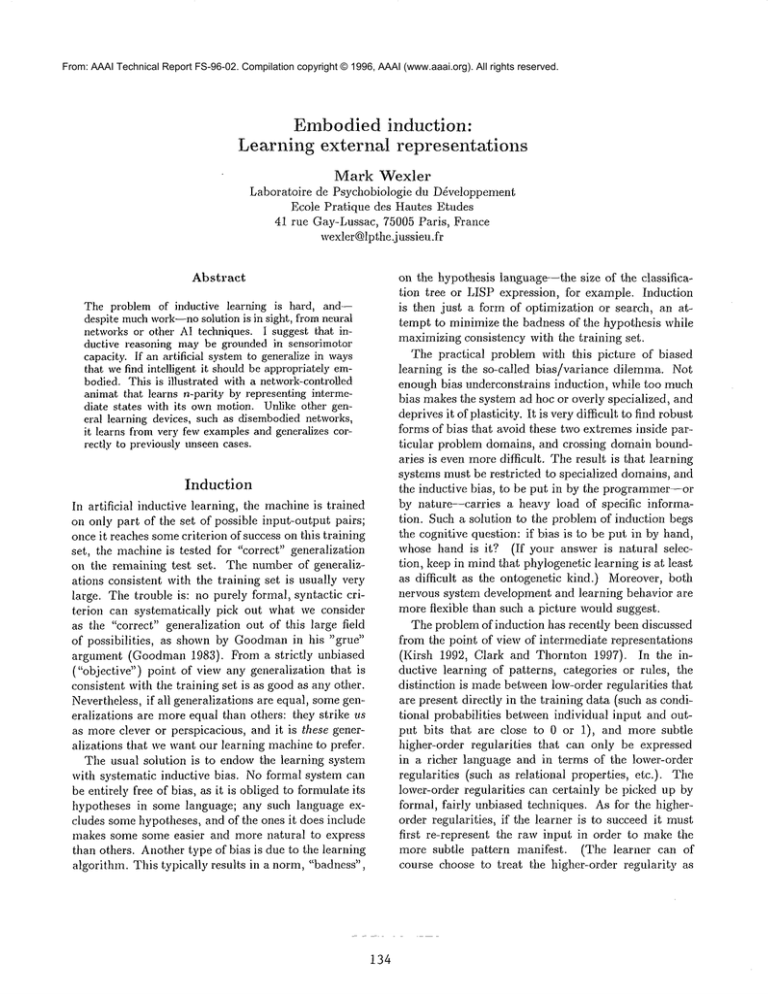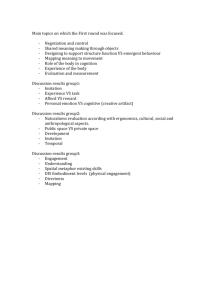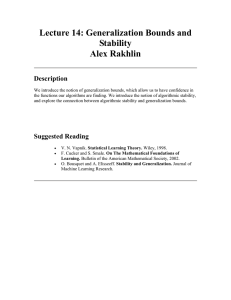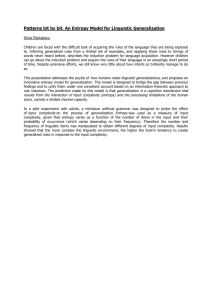Embodied induction: Learning external representations
advertisement

From: AAAI Technical Report FS-96-02. Compilation copyright © 1996, AAAI (www.aaai.org). All rights reserved.
Embodied induction:
Learning external representations
Mark Wexler
Laboratoire de Psychobiologic du D~veloppement
Ecole Pratique des Hautes Etudes
41 rue Gay-Lussac, 75005 Paris, France
wexler@lpthe.jussieu.fr
Abstract
on the hypothesis language--the size of the classification tree or LISP expression, for example. Induction
is then just a form of optimization or search, an attempt to minimize the badness of the hypothesis while
maximizingconsistency with the training set.
The practical problem with this picture of biased
learning is the so-called bias/variance dilemma. Not
enough bias underconstrains induction, while too much
bias makes the system ad hoe or overly specialized, and
deprivesit of plasticity. It is very difficult to find robust
forms of bias that avoid these two extremes inside particular problem domains, and crossing domain boundaries is even moredifficult. The result is that learning
systems must be restricted to specialized domains, and
the inductive bias, to be put in by the programmer--or
by nature-carries a heavy load of specific information. Such a solution to the problem of induction begs
the cognitive question: if bias is to be put in by hand,
whose hand is it? (If your answer is natural selection, keep in mindthat phylogenetic learning is at least
as difficult as the ontogenetic kind.) Moreover, both
nervous system development and learning behavior are
more flexible than such a picture would suggest.
The problem of induction has recently been discussed
from the point of view of intermediate representations
(Kirsh 1992, Clark and Thornton 1997). In the inductive learning of patterns, categories or rules, the
distinction is madebetween low-order regularities that
are present directly in the training dam(such as conditional probabilities between individual input and output bits that are close to 0 or 1), and more subtle
higher-order regularities that can only be expressed
in a richer language and in terms of the lower-order
regularities (such as relational properties, etc.). The
lower-order regularities can certainly be picked up by
formal, fairly unbiased techniques. As for the higherorder regularities, if the learner is to succeed it must
first re-represent the raw input in order to make the
more subtle pattern manifest. (The learner can of
course choose to treat the higher-order regularity as
The problem of inductive learning is hard, and-despite muchwork--nosolution is in sight, from neural
networks or other AI techniques. I suggest that inductive reasoning may be grounded in sensorimotor
capacity. If an artificial systemto generafize in ways
that we find intelfigent it should be appropriately embodied. Tiffs is illustrated with a network-controlled
animat that learns n-parity by representing intermediate states with its ownmotion. Unlike other general learning devices, such as disembodiednetworks,
it learns from very few examplesand generalizes correctly to previously unseencases.
Induction
In artificial inductive learning, the machineis trained
oll only part of the set of possible input-output pairs;
once it reaches somecriterion of success on this training
set, the machineis tested for "correct" generalization
on the remaining test set. The number of generalizations consistent with the training set is usually very
large. The trouble is: no purely formal, syntactic criterion can systematically pick out what we consider
as the "correct" generalization out of this large field
of possibilities,
as shown by Goodmanin his "true"
argument (Goodman1983). From a strictly
unbiased
("objective") point of view any generalization that
consistent with the training set is as goodas any other.
Nevertheless, if all generalizations are equal, somegeneralizations are more equal than others: they strike us
as more clever or perspicacious, and it is these generalizations that we want our learning machineto prefer.
The usual solution is to endow the learning system
with systematic inductive bias. No formal system can
be entirely free of bias, as it is obliged to fornmlateit~
hypotheses in some language; any such language excludes some hypotheses, and of the ones it does include
makes some some easier and more natural to express
than others. Anothertype of bias is clue to the learning
algorithm. This typically results in a norm, "badness",
134
if it were lower-order, by, e.g., simply memorizingthe
input-output pairs, or by learning bit-by-bit associations. But then it wouldfail to generalize correctly: it
will certainly have learned something, but not what we
were trying to teach it.) Tile problem of perspicacious
re-representation is thus seen as the critical component
of higher-order learning.
alize beyond the training seL in the way we would? The
only possible reason would be the biological verisimilitude of artificial neural networks; but this, apparently,
is not enough.
Embodiment
and
action
I wouldlike to suggest that the at least someof difficulties of induction in artificial systems are due to those
systems’ lack of embodiment, their incapacity for external action. By action I do not meanmuscle contractions, or the planning of complex movements, though
these are indispensable to it. What I do mean is: the
ability to act on, that is to modify one’s environment
and to perceive the results, direct or indirect, of the action. Thus, issuing verbal commandsto others counts
as action on mydefinition (provided they get carried
out, and you can perceive their effects), although in
this case the immediacy of physical feedback--an important aspect of embodiment--is lost.
A more formal way to talk about action and cognition is through the action-perception cycle. A cognitire system consists of two components, the internM and
external, at any given time each of which is in a particular state, Si and S~. At every momentthe internal,
mental state Si is mappedinto some action on the external component, executed by means of motor transducers. This action modifies the external, world state
Se -+ S~. This leads to new perceptions (via. sensory
transducers), which modifythe internal state Si --+ S~,
which leads to new actions, etc. The view of cognition
as "information processing" collapses this cycle to a
linear process--sensory input, leading to cognitive processing and modification of the internal state, leading
to motor output--which overlooks the fact that natural
cognitive systems are themselves largely responsible for
their "inputs". Even purely mental operations rely on
this external control. The role of action and embodiment has been recently stressed in the situated robotics and animat communities (although with somewhat
different motivations), in linguistics by Lakoff (1987)
and Johnson (1987), in philosophy of mind by Putnam
(1981); the view that the external half of the perceptionaction cycle plays an integral role in cognition has recently been dubbed "active externalism" by Clark and
Chalmers (1996).
Thus action, besides serving pragmatic ends, may be
fundamental to what are generally considered "higher"
cognitive functions. The main thesis of this work is
that, in particular, sensorimotor routines or schemas
may ground (Harnad 1990) the mental (and other)
erations involved in induction. In the language of Clark
and Thornton, the earliest re-representations of the re~w
input (and therefore the ones most difficult to learn)
Multi-layer neural networks have become popular
mainly due to the assumption that the intermediate
layers will somehowcarry out this re-representation,
and the magic is supposed to be that this is induced
by means of a completely mindless procedure, hillclimbing. Clark and Thornton (1997) have shown that
this is not so for a numberof difficult learning problems; the one I will discuss is n-parity, as I also use
this problem in nay toy model (see below). The
parity inapping receives n bits as input and outputs
one bit, the sum of the input modulo 2. This mapping
is hard to learn from examples because they provide
no raw statistical information: all the conditional probabilities between input and output bits are 0.5. It is
well knownthat nmlti-layer feed-forward networks can
"learn" parity by means of hill-climbing--but this is
only when they are trained on all the 2’~ input-output
pairs. No simple associationistic learning will do for
this rule: changing any bit of the input flips the answer. Reproducingthe training set is necessary but not
sufficient for having a concept or a rule; simple memorization will lead to the same result, and we would not
then say that the memorizerhas learned a rule, because
(among other reasons) no re-representation of the input has taken place. A sharper test for having learned
a rule is of course correct generalization to previously
unseen cases.
Clark and Thornton have found that no training algorithm on any network architecture leads to networks
that generalize correctly to previously unseen cases of
parity; in fact, even in the best cases it suffices to
withhold a very small fraction of the problems from
the training set for generalization to fail completely.
(Other, non-network general algorithms fail just as
badly.) This is very bad news for neural networks.
Practically, it shows how bad general network methods
are at generalization: many complex problems can be
expected to contain embeddedparity or more complicated higher-order structures, and in cases of practical
interest no system can be trained on all cases. More
fundamentally, it showsthat, at least in this case, that
when a network learns to reproduce input-output pairs,
what it has actually learned is entirely unlike the rule
that we have used to arrive at the training set. Indeed,
what reason do we have to suppose that a neural network, with its peculiar dynamicsand bias, wouldtenet-
135
The animat always starts out in the same position and
orientation (at (1,0) wherethe landmarkis at the origin,
and facing north). The parity problem is fed bit-by-big
to the input-motor network (a one-layer perceptron),
whose job is not to give the answer to the problem but
to issue motor commandsto the animat. The sensory
signals from the nnimat are fed to a second, sensoryoutput network (also a one-layer perceptron), which
at the end of the presentation of the problem is supposed to output the answer--the parity of the input
string. (To be in conformance with the action model
given above, there should also be a recurrent connection between the sensory signal and the input of the
input-motor network. Such a connection is not needed
to learn parity, but can be added without substantially
changing the results to be presented below. For more
complex problems it becomes necessary.) Having no
other representational methodsat its disposal (such internal recurrent connections), the system is obliged to
represent the problem, and to keep track of the intermediate results, by meansof its action.
0
t
0
sensor] l input
t
?vq
t
i[]~o{0f1~lJl[~It
111001
111001
(a)
(b)
Figure 1: (a) di sembodied le arning sy stem. (b ) An
embodied system used in this work.
The networks are trained by means of a genetic algorithm. Each experiment proceeds as follows. A fraction f of the 2n problems are assigned to the test set,
and are never used in training (the training set always
has an equal number of even and odd cases). In each
generation of the GAeach memberof the (initially random) population is evaluated on the 2"(1 - f) training
problems. (The weights and thresholds of the networks
are coded as 10-bit strings in the genome.) The score
on each problem is the absolute value between the output of the sensory-output network and the true answer
(since logical 0 is represented by -1.0 and 1 by +1.0,
the best score is 0, the worst is 2, and 1 is chance
level); the score on the entire training set is the mean
of the scores on each problem. The population (size
50, 10 bits/weight) is evolved by both 2-point crossover and mutation, with rank-based fitness. The experinaent was stopped as soon as a memberof the population reached criterion on the training set, a score
of 0.001 or below. (Occasionally experiments ran over
200 generations without reaching criterion; these were
discarded.) The best memberof the population is then
tested on the 2~f problems in the test set, which, I
stress, the population had never seen during its training. The average score on the best population member
on the generalization test is the score for the experiment. I ran 100 experiments for each value of f and
averaged the scores, where new training and test sets
were chosen for each experiment. (Further details available on request. All techniques used were very generic.
The results were not sensitive to small variations in the
parameters.)
may very well be provided by action schemas. This
somewhatparadoxical notion can be fleshed out by the
following toy model.
Induction
in an animat
The fine detail of one’s embodimentis probably very
important. It mayturn out, for instance, that the degree of opposability of one’s thumb constrains one’s
cognitive capacities. I believe, however, that embodiment also confers very general cognitive advantages
on the embodied system, advantages that can, and
should, be studied independently of the mechanicalphysiological details. It is mygoal, therefore, to create
a minimal modelto illustrate the general role that embodiment and action can play in cognition.
Webegin therefore with a highly simplified--but not
altogether unrealistic--embodied creature, an animat.
This particular animat lives on a 2-dimensional plane;
its external "world" state is simply its position on the
plane and its heading. Time is taken as discrete. At
each tick the animat’s nmscles receive a motor command, telling them the distance to travel forward and
the angle by which to turn. The sensory input returned
consists of the distance to a fixed landmark, and the
angle between the animat’s heading and the landmark
(given as a sine and cosine, to avoid discontinuities).
The goal is for the system to learn n-parity. To this
end we introduce two neural networks to connect the
animat to its task (the systemis illustrated in Fig. lb).
136
1.4
A~:rnat
1-2"-2-1.÷,.
.x ...........j~
1-3"~3~1
-B..
~-4".4-~
-~..
.... "" P"":""""~,.....’:’Y::.I~.
..." ::
.::::; ....
, ..........
1.2
...."
-"
1
..."
.."
0.8
""
O.a
m’"*"""
.,"
...."
..."
:"
.:"
tl"
0.2
0
.::
..,,.oi...
.:"
::"
0.6
chance level. Even the 1-2"-2-1 architecture has errors
that are 50-100 times greater than those of the embodied systems for f below 0.75. The problem length can
be increased without substantiMly changing the results:
keeping f fixed I got similar generalization performance
for 5-, 6-, and 7-parity.
A final word concerning technique. The crucial aspect of this model is the sensorimotor embodiment,not
the details of the flwo (input-motor, sensory-output)
controllers. AlthoughI used as controllers neural networks evolved by genetic algorithms--mainly because I
am familiar with these techniques--other general purpose learning systems would probably do just as well,
unless they are especially maladapted to the task. The
point is that given a proper embodiment, the task of
the controllers becomesvery simple.
..,::’:
...."
!
I |
0_2
0.4
0.6
Flacfion
of v,~h.e
k:l Wob~erns
0.8
Figure 2: Generalization error (chance=l) for embodied systems and disembodied controls
External
For the control, I wanted to make things as hard
as possible for myself by comparing the generalization performance of the embodied systems with that of
tile best generalizing disembodied networks. As shown
by Clark and Thornton (1997), feed-forward networks
for the non-temporal version of the problem are miserable at generalization. For the temporal version feedforward networks won’t do, as they do not preserve
state, and therefore at least somerecurrent connections
are required. After experimenting with a number of
architectures, I found that simple recurrent ("Ehnan")
networks generalize best. Within this class, 1-a*-b-1
architectures are best (* denotes a recurrent context
layer), and as long as b is not too large the performance depends essentially on a; b = a seems a good
choice. The three best. architectures are 1-2"-2-1, 1-3"3-1, and 1-4"-4-1. These disembodied networks were
trained by exactly the same method as the embodied
systems. It should be noted that the disembodied systems got stuck in local minima much more often than
the embodied.
The results for 4-parity are presented in Fig. 2, where
the mean generalization error is plotted against f, the
fraction of the 24 problems that were withheld from
the training set. Error of 1 corresponds to chance
level. (There is a good but uninteresting explanation for why the disembodied networks actually perform worse than chance for large values of f.) The
embodied systems generalize ahnost perfectly up to
f = 0.75. As for the disembodied networks, with the
marginal exception of the 1-2"-2-1 architecture (which
is ahnost pre-eugineered to becomea parity-calculating
flip-flop), they generalize very poorly (as do Clark and
Thornton’s models): omitting just two problems gives
very high error, and at four problems they are close to
representation
The interesting question is how fihe embodied systems
managed to generalize so well. As I have already
discussed, these systems had no internal means to
represent the problem, therefore they had to perform
all "computations" externally, i.e., by means of their
movement. All the successfully generalizing systems
adopted variations on the following strategy in the
input-motor network: do not move forward, do nothing on 0, turn by 180° on 1. To calculate parity, the
sensory-output network just has to give 0 if the animat
is facing north (the landmarkis to its left), and 1 if
is facing south (landmarkrio the right).
The representation of the parity problem spontaneously evolved by the embodiedsystems is closely akin
to "epistemic action" recently investigated by Kirsh
in the context of humanproblem solving (Kirsh 1995,
Clark and Chalmers1996). The idea. is that for reasons
having to do with humancognitive limitations, people
choose to offload certain mental operations onto the
external world; i.e., instead of performing an operation
"in the head" one performs a much simpler physical
action, lets the world evolve, and then reads off the
answer. For instance, instead of mentally rotating the
falling pieces in the computer game Tetris in order to
see where they would best fit, people oflload the rotation by physically rotating the pieces on the screen.
On-line planning is another example: instead of planning where one will turn on the next street corner, one
simply goes there, fully expecting that once there, it
will be obvious where to go. In these examples and in
manyothers, the cognitive operation is spread beyond
the confines of the cognitive system into its external
world. This kind of of[loading, I suggest, may play an
important role in grounding and channeling inductive
learning. Even when overt physical action is absent
137
(tile usual case in humanreasoning), such action and
its benefits maybe present in tile covert, internalized
form of mental imagery (visual and kinesthetic) and its
transformations, often reported in reasoning.
The conclusion we can draw is as follows. The peculiar internal dynamicsof artificial neural networks do
not lead them to generalize "correctly" (i.e., in a way
that makes sense to us) to previously unseen cases of
difficult problems such as parity--indeed, why should
they? If we trade this internal dynamics for an external, seusorimotor dynamics of a simple embodied
creature, the generalization becomescorrect. This suggests that induction is less a matter of formal selection
criteria on hypotheses,1 but rather a procedure grounded in one’s sensorimotor relations with the external
world. Indeed, we choose the hypotheses that we do,
even in abstract contexts, partly because they have a
certain meaning for us--for a human being parity is
simply more meaningful than one of the "erroneous"
hypotheses generated by the disembodied networks-and meaningis not present in formal, ungrounded, disembodied systems (Putnam 1981, Harnad 1990). The
problem of induction is to discover what is it about
certain hypotheses that makes them more meanin~ul
than others in certain contexts. Perhaps a relation to
sensorimotor schemas is part of the answer.
The obvious direction for future work is to vary
both embodiment and learning problem, to discover
the types of embodiment that can ground particular
inductive hypotheses. In doing so one rapidly realizes
that the simple architecture used here is insufficient. Its
chief drawbackis an inability to combinesimple action
schemas into more complex routines that would support more complex hypotheses. What is required is a
robust, general frameworkfor progressive modularization, combiningsimpler, successful schemas into larger
wholes. Another interesting avenue is to study howthe
external routines of the type evolved here maybe internalized. After all, we do not always use our hands
when we think--sometimes we use mental images, an
internalized form of perception and action. By varying
the internal "naental" apparatus during the course of
inductive learning, perhaps a mechanismcan be found
for the internalization of perception and action.
References
Clark, A. and Chalmers, D. 1996. The external mind.
Manuscript, Dept. of Philosophy, Washington Univ.
Clark, A. and Thornton, C. 1997. Trading spaces:
Computation, representation and the limits of unl Inductive learning in neural networksis no less formal
than in classical AI; the formal computationssimply occur
on a lowerand less explicit ("subsymbolic")level.
138
informed learning. Beh. Brain Sci. 20(1).
Goodman,N. 1983. Fact, fction, and forecast. Cambridge, Mass.: Harvard Univ. Press.
Harnad, S. 1990. The symbol grounding problem.
Physica D42:335-46.
Lakoff, G. 1987. [’Vomen, fire, and dangerous things.
Chicago: Chicago Univ. Press.
Johnson, M. 1987. The body in the mind. Chicago:
Chicago Univ. Press.
Kirsh, D. 1992. From connectionist theory to practice.
In M. Davis, ed., Connectionism: Theory and practice. NewYork: Oxford Univ. Press.
Kirsh, D. 1995. The intelligent use of space. Art. Intell. 73:31-68.
Putnam, H. 1981. Reason, truth and history. New
York: Cambridge Univ. Press.
Sejnowski, T. and Quartz, S. 1997. The constructivist
manifesto. Beh. Brain 5’ci., to appear.







